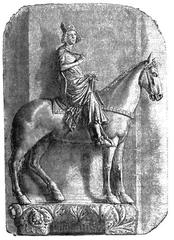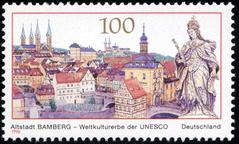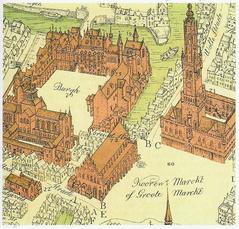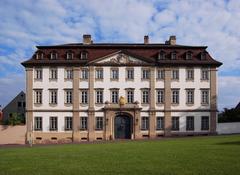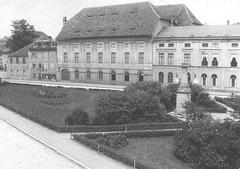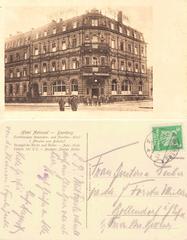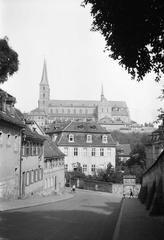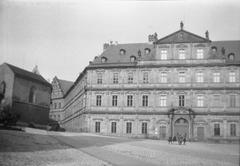Mahnmal Für Widerstand Und Zivilcourage Bamberg: Visiting Hours, Tickets, and Historical Significance
Date: 14/06/2025
Introduction
The Mahnmal für Widerstand und Zivilcourage (Memorial for Resistance and Civil Courage) in Bamberg is a powerful symbol of remembrance, honoring those who opposed National Socialism and embodying the ongoing need for civil courage in society. Located in the serene Harmoniegarten near the E.T.A.-Hoffmann-Theater in Bamberg’s historic city center, this monument commemorates the diverse strands of resistance through the dignified representation of three key figures: Willy Aron, Hans Wölfel, and Claus Schenk Graf von Stauffenberg. Since its inauguration in 2016, the memorial has become a focal point for education, reflection, and community engagement, urging visitors to move “Von der Erinnerung zur Verantwortung” (“From memory to responsibility”) in their own lives. Through its thoughtful design and programming, the site invites visitors to contemplate the legacy of resistance and the continuing importance of standing up for justice and humanity (willy-aron.de, bamberg.info, bildung-und-ethik.com).
Table of Contents
- Historical Background and Purpose
- Artistic Design and Symbolism
- Visiting Information
- Nearby Attractions
- Special Events and Community Engagement
- Frequently Asked Questions (FAQ)
- References and Further Reading
Historical Background and Purpose
Established after extensive community discussion and planning, the Mahnmal für Widerstand und Zivilcourage was unveiled on June 25, 2016. Spearheaded by the Willy-Aron-Gesellschaft Bamberg e.V., the memorial pays tribute to local and national resistance fighters against National Socialism, while simultaneously encouraging ongoing civic engagement and moral responsibility in the present. The design avoids glorifying individual heroism, focusing instead on the collective moral strength required to oppose tyranny.
Artistic Design and Symbolism
The Resistance Figures
The memorial features three over-life-size bronze busts:
- Willy Aron (1907–1934): A Jewish lawyer and Social Democrat from Bamberg, Aron opposed Nazi oppression and was arrested in 1933, dying in Dachau from mistreatment. He symbolizes the courage of ordinary citizens resisting injustice (willy-aron.de).
- Hans Wölfel (1902–1944): A Catholic jurist who supported persecuted individuals, Wölfel was executed in 1944 for his clandestine aid to regime opponents.
- Claus Schenk Graf von Stauffenberg (1907–1944): An army officer involved in the July 20, 1944, plot against Hitler, Stauffenberg’s sacrifice represents the military and aristocratic resistance (bambergguide.de).
Artistic Vision
The busts are mounted on equal-height Cor-Ten steel steles, arranged in a semicircle around a tree, symbolizing equality and unity among various forms of resistance. Two stone slabs embedded in the pavement invite visitors to reflect on questions about courage and personal responsibility. The realistic sculptural style fosters a personal connection with the commemorated individuals, while the memorial’s open layout encourages visitors to move among the figures and engage in contemplation (bamberg.info, bildung-und-ethik.com).
Visiting Information
Location and Accessibility
- Address: Harmoniegarten, near E.T.A.-Hoffmann-Theater, central Bamberg
- Accessibility: Wheelchair accessible with paved paths and close to public transit options
- Nearby Amenities: Cafés, public restrooms, and shaded benches for reflection
Visiting Hours and Admission
- Hours: Open daily, year-round, from 8:00 AM until sunset (as it is an outdoor site, hours follow daylight)
- Admission: Free of charge; no tickets required
Guided Tours and Educational Programs
- Tours: Local operators and Bamberg’s tourist office offer guided tours, often as part of broader historical city tours. Advance booking is recommended, especially for group or school visits.
- Educational Resources: Bilingual (German/English) exhibition guides are available, and the Willy-Aron-Gesellschaft Bamberg e.V. organizes lectures, school workshops, and commemorative events.
Photography and Visitor Tips
- Photography: Permitted and encouraged. The site is particularly photogenic in early morning or late afternoon light.
- Tips: For deeper engagement, consider using the Audiala app for audio guides and visiting during special events for commemorative programming.
Nearby Attractions
Complement your visit to the memorial with these Bamberg highlights:
- Bamberg Cathedral
- Old Town Hall (Altes Rathaus)
- Medieval Mikwe (Jewish ritual bath)
- Jewish Cemetery
- Stolpersteine (stumbling stones) commemorating Nazi victims
These sites, all within walking distance, offer a broader perspective on the city’s rich and diverse history (Bamberg Info).
Special Events and Community Engagement
The Mahnmal serves as a hub for remembrance and community activity. Annual commemorations, particularly on July 20th (the anniversary of the Stauffenberg assassination attempt), draw schools and civic groups for lectures and ceremonies. The Willy-Aron-Gesellschaft also facilitates ongoing projects such as Stolperstein placements and public discussions, fostering a living culture of remembrance.
Frequently Asked Questions (FAQ)
Q: What are the opening hours of the memorial?
A: Open daily from 8:00 AM to sunset, accessible year-round.
Q: Is there an admission fee?
A: No, entry is free for all visitors.
Q: Are guided tours available?
A: Yes, through Bamberg’s tourism office and local organizations; booking in advance is recommended.
Q: Is the memorial accessible for people with disabilities?
A: Yes, the area is wheelchair accessible.
Q: In which languages is information available?
A: Most plaques are in German; bilingual guides and audio tours are available.
Q: Can I take photographs at the memorial?
A: Absolutely—photography is encouraged.
References and Further Reading
- willy-aron.de
- bamberg.info
- bildung-und-ethik.com
- Bamberg Guide
- Deutsche Digitale Bibliothek
- Bamberg Info - Jewish Heritage
Conclusion
A visit to the Mahnmal für Widerstand und Zivilcourage in Bamberg provides a meaningful encounter with the city’s resistance legacy. The memorial’s thoughtful design, educational resources, and integration within Bamberg’s historic landscape make it a vital destination for anyone seeking to understand the importance of civil courage, both past and present. Enhance your visit by exploring nearby historical sites, participating in guided tours, and utilizing digital resources like the Audiala app for a comprehensive and engaging experience.


